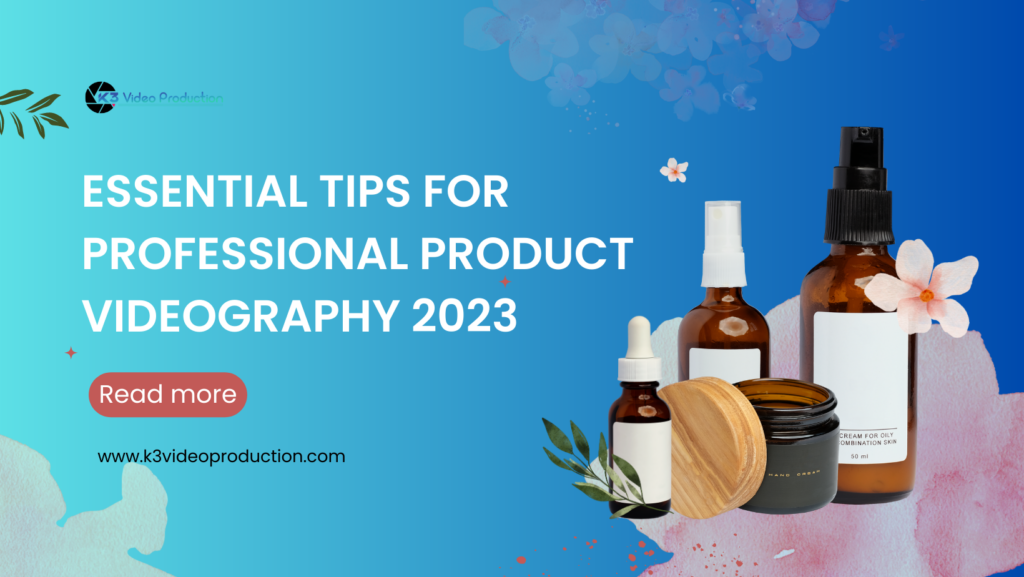Suppose you sit with marketers and ask them what one of the most significant factors is that helps companies generate leads in the current competitive world. In that case, they will probably answer via videography. From social media marketing to e-commerce, whichever domain you name, videography is demanded in some way or another. This is because people prefer Video production more than before. After all, it has also increased the conversion ratios and sales.
Table of Contents
ToggleThe video has emerged as a competitive product promotional strategy because of the current technological advancement in the world. Affiliate markets, media in general, e-commerce businesses, and even marketing specialists will find that shooting videos to convey product aspects is crucial. Here are some valuable tips to help you create captivating product videos that capture all the necessary details:
Tips for Product Photography
1. Plan and script your video
Having a roadmap is very necessary. To avoid wasting time and coming up with a subpar video, ensure that you plan and write down how the video will look like to a T. It is crucial to determine what specific aspects and characteristics are relevant to the theme and should be emphasized. To avoid forgetting the key points you may need a proper script that will guide you throughout the filming moment. In some of the cases, the brand may wish to unveil certain details concerning the product, so ensure to relay that to the client where applicable.
2. Use proper lighting
This has very major importance not only in photography but also in videography processes. Idea: Lighting plays an important role in photographing products and their features. This can be done by lighting the scene with soft light and diffused light in order to prevent strong highlights and reflections. Another aspect to consider is light; natural light is the best, but if filming inside, one can purchase cheap lighting equipment or use lamps to set appropriate lighting conditions.
3. Choose the right background
The background of your video is an element that may help you emphasize your product in the best possible way. Choose a background that you will not make your audience focus more on what lies behind the product rather than what is in the picture. Light-colored clothing a relatively white background, or even a natural environment, elicits the best results.
4. Backdrop
As with the abovementioned point, this point must also be made. It also means there should be a commonality between the backdrops, prop sizes, and lighting. Placing things that are being explained should be done on a table with a white cloth covering it, and the environment should have adequate lighting.
5. Utilize different camera angles
This is necessary to get all the features of your product and present them to your customers and buyers. This will enable your viewers to be well briefed on how they should shape it, design it, and how they should use it. To shoot everything necessary, use multiple angles, including aerial, progressive, and zoom.
6. Showcase specific features and benefits
In product videos, you can target what sets your product apart and sell that in particular detail. Always dedicate quality time to detailing aspects of the digital interface and justifying their utility. For instance, justify how a given aspect will make the product easier to use or improve its functioning.
7. Incorporate close-up shots
Macro views are effective since they will capture the actual aspects of your product, such as its surface, material, and other nuanced features that may be difficult to notice in a casual inspection but will be very useful for creating an identifiable image of your product. A macro lens or a particular shot for detailing – any polished product, be it your creation, a material, or anything else that distinguishes your object.
Hiring a professional Video production company can go a long way in ensuring that you can get those minor and major details that are always needed to add value and emphasis to details that you may want displayed on the product. This is heavily based on the notion of rich experience as well.
8. Use motion and smooth camera movements
By incorporating movement into your product video, there will be more appeal when watching, and this can greatly enhance people’s experience. Integrate secondary motions such as smoothly rotating the camera, panning and zooming into various parts of the product with effect. However, they should move around the scene smoothly and carefully so that the movements do not affect the stability of the shot.
9. Capture product interactions
Further show how the product may be utilized or engaged with as the case maybe. This way the viewers are allowed to see how it works to solve the issues affecting them. For instance, if you are illustrating a kitchen gadget, ensure that you film people using it to cook food.
10. Incorporate callouts and text overlays
Check whether it is appropriate to add captions, titles, or labels on the video or specific frames to convey more information. This enables viewers to understand features at a glance or gain further elaborations aired in case of comprehension difficulties.
11. Edit and polish your video
Once you have done filming, it is time to cut your movie, make it look more artistic, and provide it with background music or commentary, and proper sequencing. Sift through the recording and cut anything that adds no value, and overlay the text if need be, or adjust anything to suit the video quality needed.
12. Always use a tripod
Typically when recording something, or someone talking or presenting a particular product. It helps to get rid of awkward movements like camera shakes and other unwanted movements in footage that are difficult to eliminate or conceal using effects.
13. Tips for beginners
Try to find out what is good or bad. Do not refrain from experimenting with novel concepts until you become more experienced and knowledgeable. You can also refine your work as far as shooting and editing is concerned once you have shot a few videos, edited and completed them. When you have understood what you should and should not do you can destroy the initial few videos and produce a superior one. Ensure someone competent and close to you watches the finished videos and gives inputs.
14. Digital video set
For each set of digital videos or the products you are presenting, it is important to create different folders for storage. To ensure a well-organized structure for the files, create subfolders for the final video, noises, audio, and source videos. If it’s sorted by different projects, it also helps your to extend other kinds of information, for example, audio, background music etc., all along the process of the editing.
A few additional points to consider
- Is it a demonstration video?
If the video is being used as a demonstration, it’s critical that you comprehend how the product functions. You must also be able to communicate this message to customers. You want to demonstrate how simple the product is to use or put together. This frequently entails employing various strategies, such as voiceovers, and shooting the final result from various perspectives. It’s critical to have a solid working knowledge of a range of photographic techniques, including lighting a product. Get in touch with a professional video production to understand this in a better way.
- Is it a video for a product launch?
The item can be a prototype for a brand-new item. You must create buzz around new releases, whether popular books or new products. The main goal here is to make buyers enthusiastic about the new product or interact with an existing fan base. You are generating enthusiasm with what you are doing.
- Although sound quality is crucial, visual quality is paramount. It is advisable to use background music or be silent if you cannot provide a suitable soundtrack.
- Don’t ever improvise. Here is where everything may go wrong. You squander both your own and the client’s time.
- Make sure you are aware of how to use light. Working with natural light is acceptable when you are on a tight budget, but be careful to do it correctly.
Summing Up
Capturing product details on a video requires careful planning, attention to detail, and creative execution. Following these essential tips, you can create compelling product videos that effectively showcase your offerings, captivate your audience, and drive sales and engagement. However, it is highly recommended to contact a professional Video production company to get the job done perfectly.
FAQs
1. Why is videography important for product marketing?
Videography is crucial for product marketing because it effectively showcases product details, engages viewers, and boosts conversion rates. Videos help communicate the features, functionality, and benefits of products, making them an essential tool for eCommerce, social media, and other marketing channels.
2. What are the initial steps to take before filming a product video?
Before filming, it’s important to plan and script your video. Identify key features and details to showcase and create a well-thought-out script to stay organized and ensure nothing important is missed. Communicate with clients about any specific information they want to highlight.
3. How important is lighting in product videography?
Lighting is crucial in product videography as it enhances the visibility and appeal of product details. Use soft, diffused lighting to avoid harsh shadows and reflections. Natural light is ideal, but affordable lighting kits or well-placed lamps can optimize indoor filming conditions.








